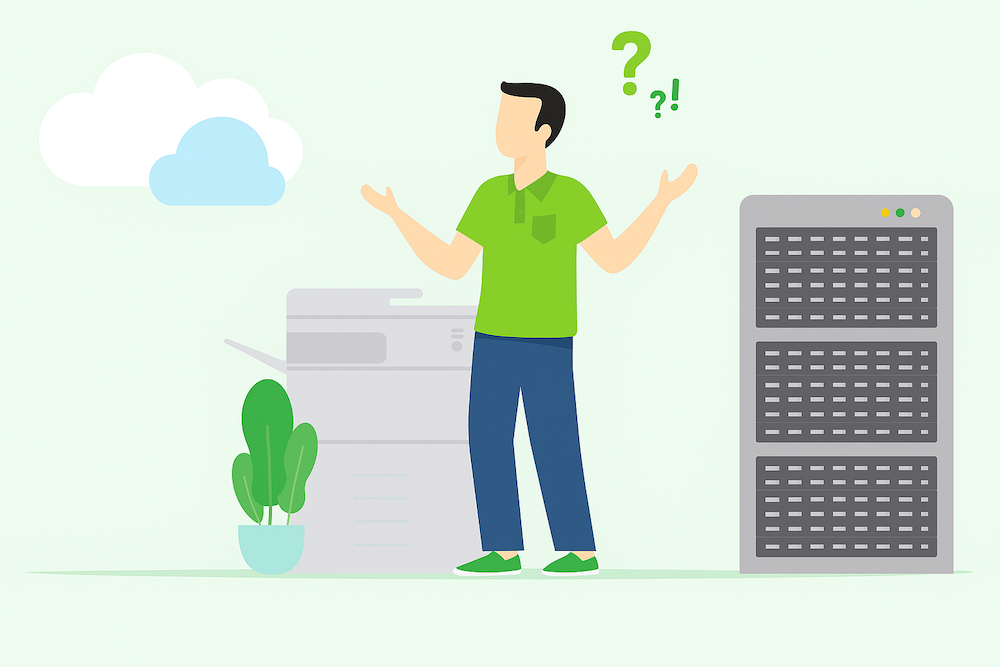In a world where nearly everything is moving to the cloud, emails, files, collaboration tools, it’s no surprise that printing has followed suit. But for many businesses, the question remains: Should we stick with traditional printing or make the switch to cloud printing?
Both options have their advantages, and the right choice often comes down to how your team works, what your IT resources look like, and what level of flexibility or control you need. In this post, we’ll break down the key differences between cloud and traditional printing, explore the pros and cons of each, and help you determine which setup makes the most sense for your business.
What Is Traditional Printing?
Traditional printing refers to the setup most offices have relied on for decades. It typically involves connecting printers directly to users’ computers or via a central print server that handles jobs across the network. Each workstation may require its own driver installation, and access is usually limited to people on the local network.
Key Features:
- Local print servers that manage print queues and permissions
- Direct network connections or USB links between devices and printers
- Manual driver installations for each user or device
- No dependency on the internet: everything runs within your local IT environment
This model has stood the test of time, offering high reliability, predictable performance, and tight data control. However, as business environments change, especially with hybrid and remote work, its limitations are becoming more noticeable.

What Is Cloud Printing?
Cloud printing moves the traditional printing infrastructure off your local servers and into the cloud. Instead of sending print jobs through your internal network, cloud printing platforms allow users to print through a web-based service. Jobs are transmitted securely to cloud-connected printers from virtually anywhere.
Key Features:
- No local server required: print services are managed in the cloud
- Remote accessibility for mobile and off-site users
- Automatic updates for drivers and printer management tools
- Web-based management consoles for easier IT oversight
Cloud printing can integrate with identity systems (like Microsoft 365 or Google Workspace) and supports printing from smartphones, Chromebooks, and personal laptops which is ideal for distributed teams.

Traditional Printing: Pros and Cons
Pros
- No internet required: Everything stays within your internal network, which can reduce exposure to outside threats and minimize reliance on connectivity.
- Better for legacy systems: Some older equipment or industry-specific workflows may not be compatible with newer, cloud-based solutions.
- Full data control: Especially for organizations handling sensitive data (like law firms, healthcare providers, or financial institutions), local control over data transmission can be a priority.
- Predictable performance: Local printing tends to be faster and more consistent for high-volume jobs since there’s no dependency on internet bandwidth.
Cons
- Higher IT workload: Your internal IT team (or service provider) must manage print servers, driver updates, user access, and security patches.
- Limited mobility: Employees need to be on the same network, or connected via VPN, to print, which isn’t ideal for hybrid or mobile teams.
- Scalability is complex: Adding printers across new locations requires setup, configuration, and often on-site support.
- Outdated infrastructure risk: Print servers and local hardware can become a bottleneck if not regularly maintained or upgraded.
Cloud Printing: Pros and Cons
Pros
- Supports remote and hybrid work: Employees can send print jobs from home, a coworking space, or the road, no VPN required.
- Simplifies IT management: No need to manage on-premise servers or install drivers on every machine. Most updates happen automatically through the cloud platform.
- Scales with ease: Add users, devices, or new locations with a few clicks—no onsite setup necessary.
- Enhanced visibility and control: Admins can track usage, set quotas, and monitor printer status from a web-based dashboard.
Cons
- Internet required: If your connection goes down, cloud printing may be temporarily unavailable.
- Security considerations: While reputable platforms encrypt data in transit and at rest, cloud-based transmission of sensitive documents may raise concerns for some industries.
- Printer compatibility: Older printers may not support cloud printing natively. You might need to invest in connector software or upgrade your hardware.
- Subscription costs: While cloud printing eliminates hardware maintenance, you may pay for a SaaS-style subscription depending on your platform.
How to Decide: Cloud vs. Traditional Printing
Choosing the right printing approach depends on how your business operates and where it’s headed. Consider factors like:
- Do your employees work remotely, or bring their own devices?
If yes, cloud printing supports mobile users and hybrid work better. - Is your IT team stretched thin?
Cloud printing reduces administrative burden and eliminates the need to maintain on-prem servers. - Do you work with highly sensitive information?
Traditional printing may offer greater control and compliance in regulated industries. - Are you planning to grow or open new locations?
Cloud printing scales more easily without infrastructure overhaul. - Are your current printers cloud-compatible?
Some legacy hardware won’t support cloud services without add-ons or upgrades.
In short, cloud printing offers agility and convenience, while traditional printing delivers control and stability. Your best option depends on where your team is now—and where you’re going.

Real-World Scenarios
Let’s look at two sample businesses that face different printing needs:
Scenario 1: Law Office Using Traditional Printing
A mid-sized law firm processes confidential legal documents daily. Their team is primarily in-office, and their printers are configured for secure pull printing on an internal network. With strict compliance requirements and limited tech change tolerance, traditional printing offers the control and reliability they need without sending sensitive files to the cloud.
Scenario 2: Marketing Agency Using Cloud Printing
A creative agency with remote designers, photographers, and two satellite offices needs flexible printing across locations. They use Chromebooks and MacBooks, making traditional driver installs cumbersome. By switching to a cloud-based solution, their team can print project files on demand from any location without bogging down IT or requiring VPN access.
Can You Have Both? Exploring Hybrid Printing Models
The good news is that you don’t always have to choose one or the other. Many businesses are now embracing hybrid printing, which combines cloud functionality with local infrastructure.
What does a hybrid print setup look like?
- On-site printers still function through a local network.
- Cloud-based services manage print job routing, security, and access control.
- Users can print from anywhere, but internal jobs never leave your firewall.
This model allows companies to enjoy cloud flexibility while maintaining internal control.
Which Printing Setup Is Right for You?
The best print environment is one that supports your workflows, enhances your team’s productivity, and aligns with your IT capacity. Whether that’s a reliable, traditional setup or a flexible, cloud-based model depends on your needs.
Choose traditional printing if you:
- Handle sensitive data under regulatory requirements
- Operate from a single location
- Prefer full internal control over infrastructure
Choose cloud printing if you:
- Support hybrid or mobile workers
- Want to reduce IT management
- Need scalable solutions across multiple sites
Or, consider a hybrid model for the best of both worlds.
Print Smarter, Not Harder
Whether you’re managing sensitive documents from a single office or supporting a fast-moving team across multiple locations, the right printing setup should make your work easier, not more complicated.
Cloud printing offers the flexibility and scalability today’s businesses often need, while traditional printing still delivers unmatched control for certain environments. The key is choosing a solution that aligns with your workflows, security needs, and future goals. Not sure where to start? A print environment assessment can help you cut through the noise and find the smartest path forward.
About United Business Systems
United Business Systems specializes in simplifying the complexity and management of office technology solutions for over 7,800 organizations nationwide. Services include Managed Print, Document Management and IT Services. Products include MFPs, Copiers, Printers and Wide Format Printers. UBS’s headquarters is in Fairfield, NJ with branch offices in Moorestown, NJ, Manasquan, NJ and New York.For the latest industry trends and technology insights visit UBS’ main Blog page.


